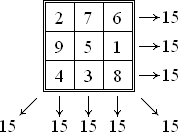Magic constant
The magic constant or magic sum of a magic square is the sum of numbers in any row, column, or diagonal of the magic square. For example, the magic square shown below has a magic constant of 15. In general .

The term magic constant or magic sum is similarly applied to other "magic" figures such as magic stars and magic cubes.
Magic stars
The magic constant of an n-pointed normal magic star is .
Magic series
In 2013 Dirk Kinnaes found the magic series polytope. The number of unique sequences that form the magic constant is now known up to .[1]
Physics
In the mass model the value in each cell specifies the mass for that cell.[2] This model has two notable properties. First it demonstrates the balanced nature of all magic squares. If such a model is suspended from the central cell the structure balances. ( consider the magic sums of the rows/columns .. equal mass at an equal distance balance). The second property that can be calculated is the moment of inertia. Summing the individual moments of inertia ( distance squared from the center x the cell value) gives the moment of inertia for the magic square. "This is the only property of magic squares, aside from the line sums, which is solely dependent on the order of the square" [3]
See also
External links
References
- ^ Walter Trump http://www.trump.de/magic-squares/
- ^ Heinz http://www.magic-squares.net/ms-models.htm#A 3 dimensional magic square/
- ^ Peterson http://www.sciencenews.org/view/generic/id/7485/description/Magic_Square_Physics/



